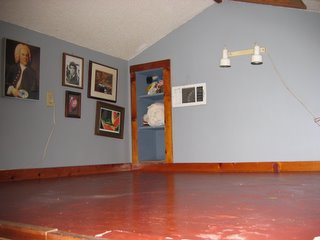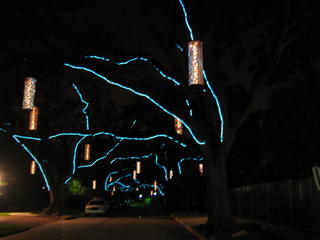Interview Time I need to steer away from storm reportage for a while and get back to knitting.
I have received by personal e-mail the following unsolicited questions from one Kelly Rice of New York who informs me that cross-interviewing is popular amongst those who blog.
Having never been interviewed about my blog before, I'll give it a whirl.
[tapping microhone]
"mic check .. test one, test one..."
[cough]
Hi Kelly, thanks for interviewing me.
Why do you blog?
Because I have knitworthy things to say and I don't have time to chase publishers.
Also, so I don't have to stay on topic, an activity contrary to my nature, and because I can say anything I damn well please without someone else editing it.
If I did manage to find a publisher who was willing to print my ramblings, the book would either be entirely unclassifiable in the Library of Congress, or else it would have to be cross-referenced under: knitting, animal sheltering, yarn, herpetology, politics, spinning, animal behaviorism, fiber, meteorology, Star trek, drop spindles, animal husbandry, rock and blues music, nautical knots, fleece preparation, ghost legends, weaving, herbal remedies, natural dyes, sheep, alpaca, things you can do with a Swiss Army knife and duct tape, how to use objects for purposes other than their intended use, and 10,849 Reasons to Spay or Neuter Your Pet. .
That not being possible, I blog.
How big is your yarn stash?
Bigger than a breadbox.
Actually, much bigger than a breadbox.
But not all that big compared to some legendary stashes of which I am aware, and if I blew a whistle and ordered it all to assemble in one place it would probably fill an average closet.
Well, maybe a very large closet.... if I subdued it by compressing it into those clear-plastic vaccuum-bag things, a process which reminds me of 1960s moms squishing themselves into girdles. What seems beyond comprehension can be done with force of will.
Seriously, though, my stash remains considerably smaller than stashes of legend, even smaller than the stashes of a few friends.
However, the relatively small size of my yarn stash is more due to the small-ish size of our house than it is due to lack of covetousness for more yarn, and also due to the fact that every other cubic inch of available storage space in our house is occupied by my husband's impressive collection of Vintage Computer and Stereo Components.
Some even work.
What is the strangest object you have ever knitted?
Hmmmm. I have knitted a lot of strange objects, including a tea cozy that looked like a Tribble, a hat-scarf (a harf?) resembling a boa constrictor -- the hat-end was the mouth, which engulfed the wearer's head, and the scarf-part wrapped around the neck in a very fetching manner.
There was also a curled-up-snake pillow I knitted for my former veterinarian as a retirement gift, a toilet tissue cozy resembling R2D2 for a friend enamored with Star Wars, and a one-armed sweater for a three-legged dog. Those are just a few oddities off the top of my head, but I am afraid they were all gifts and I no longer have visual documentation.
But, I shall not disappoint you.
Currently in my possession is a hat I made that looks like an armadillo. I will update this post with a photo of said hat over the weekend.
Oh! And I also have knitted a case for my blowgun -- probably not too many hand-knit blowgun cases going around -- but I don't have a picture handy. Coming soon.
Why do you knit?
Because there is yarn.
What are your non-knitting interests?
There are non-knitting interests?
No, seriously.
See my answer to Question Number One.
I always ask knitters if they knit in public, and if they do, when they started. How about you?
I knit everywhere. I keep a sock project in my purse/tote at all times, a mindless car project (usually pet cozies), and a five-gallon plastic kitty litter bucket under my desk at the animal shelter containing a mini-stash of needles and scrap yarn for pet cozies and cat toys. This way I can knit on my lunch breaks, that is, when I actually get a lunch break, and I can be certain that if I am trapped somewhere away from home, I will not be devoid of knitting.
When I was a teenager, I thought of knitting and crochet mostly as sedentary activities, so I mostly knitted at home, although I sometimes popped a project into my backpack when I bicycled to the park on fine days.
In college, I often carried a small project in my backpack to knit between classes. I often ventured into the common room of our dorm with my knitting to watch TV or study, where I met a dorm-floor-mate who knitted, and we began to take our knitting with us to a college pub to watch Star Trek re-runs (the Captain Kirk Generation) after the evening news and drink 50-cent mugs of draft beer.
To be a member of the Star Fleet Beer Academy, you had to stand up facing the pub TV when the show began, raise your mug high in the air, intone the introduction ("Space, the final frontier...") and sing (or, more correctly, "ooooh") the entire wordless Star-Trek tune, you know:
"woo-OOH-woo-ooh-hooh-OOH-hoo...."
Then you would sit down, drink your beer and watch Star Trek. This was not an initiation ritual. All members were required to do this each and every time an episode began.
At the top of their lungs.
After that, I figured I could knit in public just about anywhere.
What inspires your creative process?
I like structure and texture. I see the structure of things in nature, architecture, sculpture, ceramic tile, bones, leaves, spiderwebs, animals, plants, bricks, stained glass windows, and especially American Indian and African art ... also ancient graphic patterns, like the borders on Greek urns ... and I want to copy or mimic these things.
One of the reasons that winter is my favorite time of year is that I can see the architecture of the trees and the true depth of the woods, not just the exterior wall of biomass we see in the summer. Trees and leaves are endlessly inspiring for lace.
I feel the texture of bark, soft moss, a birds nest, twisting vines, and I want to duplicate them.
I like both subtle and brilliant variations of color and I like to mimic the color patterns of snakes, birds, sunsets and geological color patterns. I especially like to play with colors to get camouflage-like variations in hue and tone -- think Koigu yarn or Noro here. I am a huge fan of space-dyed yarn.
I also like to use contrasting or complimentary space-dyed yarns to do Fair Isle or other colorwork. It always looks so much more complex than it really is.
Math and geometry are inspiring. I like to play with Fibonacci numbers and proportions, and number sequences for striping.
Also inspiring, mathematically, is the actual three-dimensionality of knitting. Working out a complicated shape is very inspiring to me.
And sometimes, I have a couple of glasses of wine and suddenly, urgently decide that I really, really need a purple mohair-and-eyelash scarf, or a hat that looks like an armadillo.
Do you have any knitting fantasies?
Many. I dream of taking a knitting cruise to Alaska or Patagonia. I dream of winning the Koigu Lottery. I dream of taking a knitting, camping and walking tour of Ireland, England and Scotland and all the wee British Isles which have inspired so much knitting. One day, I would like to make an Orenberg lace shawl.
Making an Orenberg shawl would require a considerable amount of Uninterrupted Sitting-Down Time, another fantasy of mine.
And ... I have a much more humble dream of simply having two weeks off work to visit Luisa Gelenter at her shop, LaLana Wools, in Taos and do absolutely nothing but knit and soak up the scenery. I would also like to visit my Knit Bud Lisa Louie in Hawaii, sit on the beach, knit, and drink large, pink rum drinks with purple paper umbrellas sticking out of them, and enough fruit in them to make Carmen Miranda a hat. There are many other people on KnitU I would like to visit and LYS owners I would like to meet as well.
I admit that I have also visited the Biltmore Estate in North Carolina and seriously wondered how much yarn I could fit in there if somebody would let me live there for awhile.
Have you ever considered opening your own LYS?
I have fantasized about it .. and consider it best left as a fantasy.
My mother spent her working life in retail and is very, very good at managing all that orderly stuff like inventory and payroll and taxes and quarterly statements. She was able to say "no" to salespeople trying to fob off inventory of questionable marketability, and she also has had the steel spine and cast-iron strength of will not to bring every single thing in her shop home with her.
I am not in my mother's league and will not pretend to be. It's bad enough that I go into a shop looking for a 60-inch, size 5, Addi Turbo needle for a poncho, and come out with the needle, six skeins of Koigu for a shawl and enough Inca Alpaca for a sweater.
I justify this by deciding that the shawl is for my mother and my total purchase costs less than one hour with a decent psychiatrist.
I work at an animal shelter and we have 15 pets, okay? So I can only imagine how soundproofed and well-insulated our house would be if I owned a yarn store. Hmm, think of what I could save on utilities....
--Mambocat












